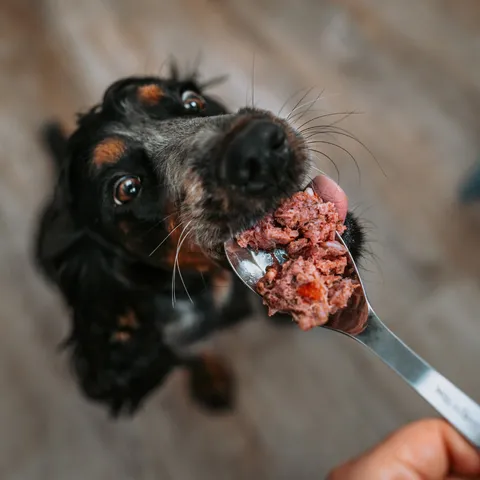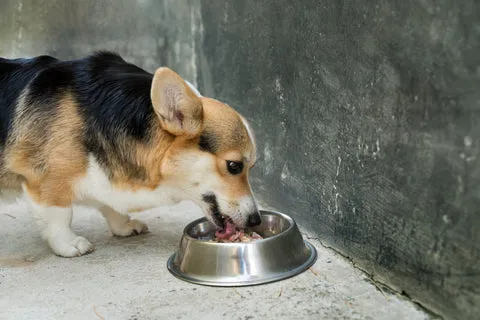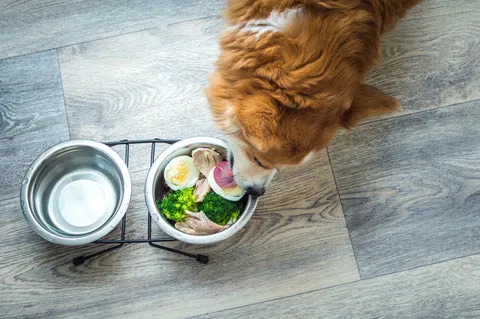It’s always concerning when your dog isn’t feeling well. A healthy dog usually has a good appetite, so when they’re sick, it’s natural to worry about what they should eat. Just like humans, dogs often lose interest in their regular food when they have an upset stomach or are feeling under the weather.
Providing nutritious food is crucial to help your sick dog regain energy and recover quickly. This guide provides a comprehensive overview of the best foods to feed your dog when they’re not feeling their best, whether it’s due to a simple upset stomach or food allergies.
What to Feed a Sick Dog
 Dog looking at food bowl
Dog looking at food bowl
When your dog is sick, a plain, easily digestible diet is usually the best approach. It’s a good idea to keep some healthy, bland food options on hand so you can quickly provide relief when your dog’s health takes a turn. However, if your dog’s condition doesn’t improve, consult your veterinarian for further advice. Here are ten excellent food choices for dogs with upset stomachs:
1. Boiled White Meat
 Chihuahua
Chihuahua
Plain white meat, such as chicken or turkey breast, is easy to digest and low in fat, making it a perfect choice for a sick dog. It provides lean protein that can help soothe your dog’s stomach. Always remove the skin and bones before feeding it to your dog to prevent choking and make digestion easier.
To prepare the meat:
- Rinse the meat thoroughly under cold water.
- Remove any excess fat, skin, or bones.
- Place the meat in a pot and cover it with water. Bring to a boil, then reduce the heat and simmer for 15-20 minutes.
- Drain the water and cut the meat into small, bite-sized pieces.
- Allow the meat to cool before serving it alone or with white rice or vegetables.
2. White Rice
White rice is a common ingredient in many dog foods and a good option when your dog is sick. While brown rice is more nutritious, the blandness of white rice makes it easier to digest, especially when your dog has an upset stomach. You can also check what can you feed a puppy for more ideas on bland diets.
If your dog has diarrhea, white rice can help bind their stools, aiding in the return to normal digestion.
To cook the rice:
- Rinse the rice under cold water.
- Add the rice to a large pan, using two parts water to one part rice.
- Bring to a boil, adding a pinch of salt.
- Reduce to a simmer, cover the pan, and cook on low heat for about 18 minutes, or until all the water is absorbed.
- Let it rest and cool; fluff with a fork before serving.
3. Sweet Potatoes
 Sweet potato slices on a table
Sweet potato slices on a table
Cooked sweet potatoes are rich in vitamins and fiber and gentle on the stomach, making them an excellent choice for soothing your dog’s digestive system. They provide essential calcium, iron, and magnesium, which can aid in your dog’s recovery.
Avoid feeding your dog raw sweet potatoes, as they are harder to digest and can further upset their stomach. Peel the skins, chop the potatoes into chunks, and boil them until soft. Drain and mash them before serving, ensuring they’ve cooled down.
4. Pumpkin
Pumpkin is another effective food for curing an upset stomach and helping a sick dog feel better. It’s rich in vitamins that help boost the immune system and contains plenty of fiber, which can aid in regulating digestion.
 Husky with a pumpkin slice smile
Husky with a pumpkin slice smile
Give your dog up to four tablespoons of pumpkin with their meal (or with chicken and rice) to aid recovery. Canned pumpkin is effective if it has no added sugar, seasonings, or ingredients that could worsen your dog’s stomach issues.
5. Homemade Bone Broth
 Puppy licks it
Puppy licks it
Bone broth is beneficial for sick dogs because it provides essential nutrients and minerals like sodium and potassium, while also helping to keep them hydrated. Avoid using garlic or excessive salt, as these can further upset their stomach.
Low in carbohydrates, bone broth is gentle and easy to digest, making it an excellent choice for dogs with upset stomachs.
To prepare bone broth:
- Add beef or pork marrow bones and chicken or turkey bones to a large cooking pot.
- Cover with water and cook on low heat for 20-24 hours.
- Strain to remove the bones and serve the liquid.
6. Baby Food
If your puppy is having stomach issues, stage 2 meat-based baby foods like chicken, lamb, and turkey can be a suitable option. However, ensure the baby food does not contain ingredients that are toxic to dogs, such as garlic or onion powder.
 Doodle puppies eat from a plate
Doodle puppies eat from a plate
Baby food is easy to chew and digest and can help treat stomach issues and diarrhea. If you’re unsure about specific ingredients, consult your veterinarian.
7. Fish
Fish is a good source of healthy fats and vitamins that can boost your dog’s health and immune system when they’re struggling with an upset stomach. Check what meat shouldn t dogs eat for meats that are good for dogs.
The strong smell of fish can also entice your dog to eat, encouraging them to return to their bowl after losing their appetite.
The best way to prepare fish for your dog is by poaching it:
- Add the fish to a pan of water, bring it to a boil, then reduce and simmer for 10-15 minutes until cooked.
- Remove all bones and cut the fish into small pieces before feeding it to your dog.
 Corgi eats from its bowl
Corgi eats from its bowl
8. Oatmeal
Plain, cooked oatmeal can help soothe your dog’s upset stomach. High in fiber, it can aid constipation and contains antioxidants that reduce stomach inflammation.
 A bowl of oatmeal on a wooden tabel
A bowl of oatmeal on a wooden tabel
Be careful not to overfeed oatmeal, as too much fiber can make your dog feel worse.
9. Yogurt
Plain yogurt full of probiotics and free of added sweeteners is ideal for a dog with an upset stomach. It aids digestion and supports gut health, and can help regulate their digestive system.
 Puppy with yoghurt in its beard
Puppy with yoghurt in its beard
Plain, natural yogurt is readily available and can be frozen for a cool treat on a hot day.
10. Eggs
 Dog eats eggs and vegetables from its bowl
Dog eats eggs and vegetables from its bowl
If your dog isn’t vomiting, eggs are a gentle food choice and provide a good source of protein. They are also a great energy booster if your dog feels lethargic after being ill.
Scrambled without butter or oil, or boiled, are the best ways to cook eggs. Avoid eggs completely if your dog is vomiting.
What to Feed a Dog with Allergies
If your dog regularly suffers from an upset stomach, consult your vet to determine if they have food-related or breed-specific allergies. While regular kibble can be problematic for some dogs, there are alternative options designed with your dog’s health in mind.
Cold Pressed Dog Food
Cold pressed dog food is a great alternative to kibble, especially if your dog has food-related allergies. It undergoes minimal processing at lower temperatures than traditional kibble, retaining more nutritional value. You should also avoid what can german shepherds not eat to avoid allergic reactions in your dog.
 Cold-pressed dog food is easily broken down, ideal for sensitive stomachs.
Cold-pressed dog food is easily broken down, ideal for sensitive stomachs.
Because of its production method, cold pressed dog food is easily broken down, making it ideal for sensitive stomachs. It aids digestion and breaks down at the same rate as raw food, so it can be easily fed alongside a raw diet.
Available in various flavors, including white fish, salmon, and chicken, cold pressed dog food is a perfect choice for keeping your dog happy and healthy. Grain-free options are also available for dogs with grain-related allergies.
Insect Protein Cold Pressed Dog Food
Complete and nutritionally balanced, insect protein cold pressed dog food is created using the same method as meat protein options, pressed at a lower temperature to retain nutritional value and aid digestion.
 Collie dog with Wilsons Insect Protein Food
Collie dog with Wilsons Insect Protein Food
Insects contain more protein than chicken or beef, ensuring your dog receives essential nutrients. Insects are also hypoallergenic and low in purines, making them ideal for dogs with sensitivities or meat-related allergens.
Raw Frozen Dog Food
If your dog is fussy or sensitive to their current kibble, raw food can be a great way to change their diet. Raw food is made from natural ingredients that have been minimally processed and are grain-free, aiding digestion and improving coat, skin, and overall health.
 Dougal eating raw and cold pressed food
Dougal eating raw and cold pressed food
There are two main options: an 80/10/10 mix of meat, offal, and bone, and a 70/10/10/10 mix with added vitamins and minerals, giving you the option to mix with your own vegetables and minerals to cater to your dog’s specific allergies.
Conclusion
Knowing what to feed your dog when they’re sick or have allergies can make a significant difference in their recovery and overall health. By choosing easily digestible, nutritious foods, you can help soothe their upset stomach and provide the necessary nutrients to boost their immune system. Always consult your vet for personalized advice and to address any underlying health issues.
